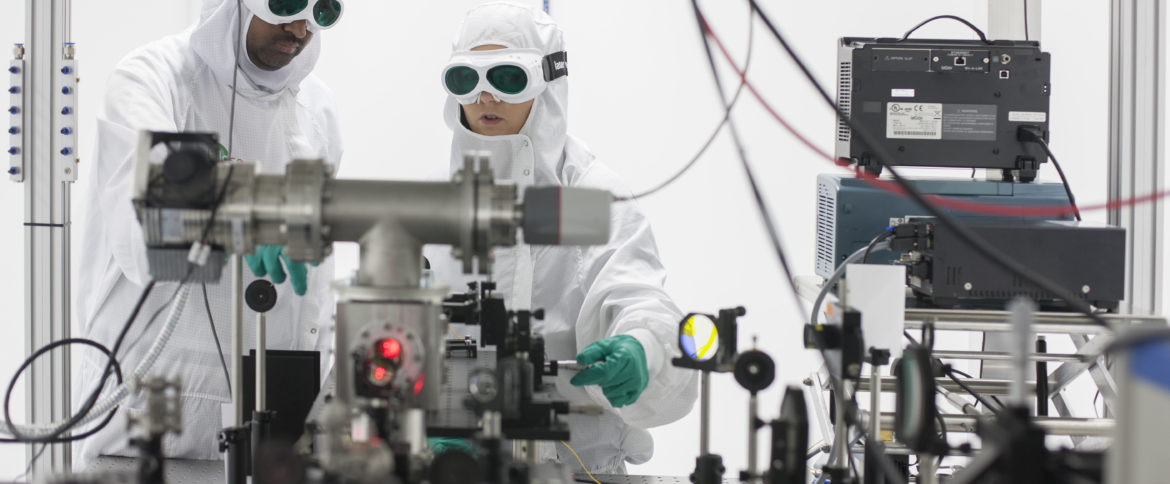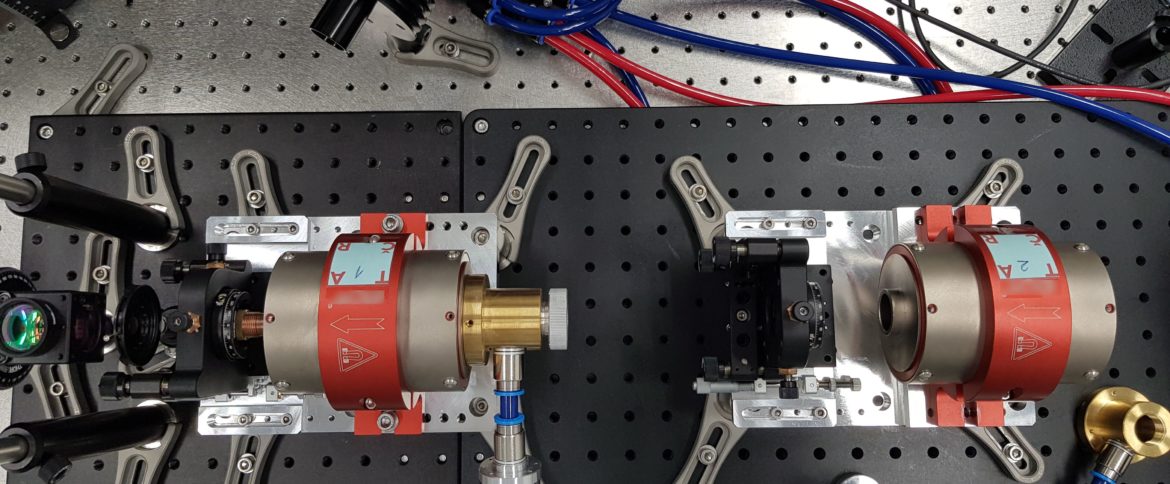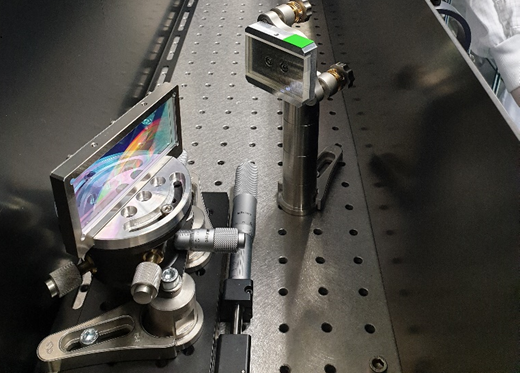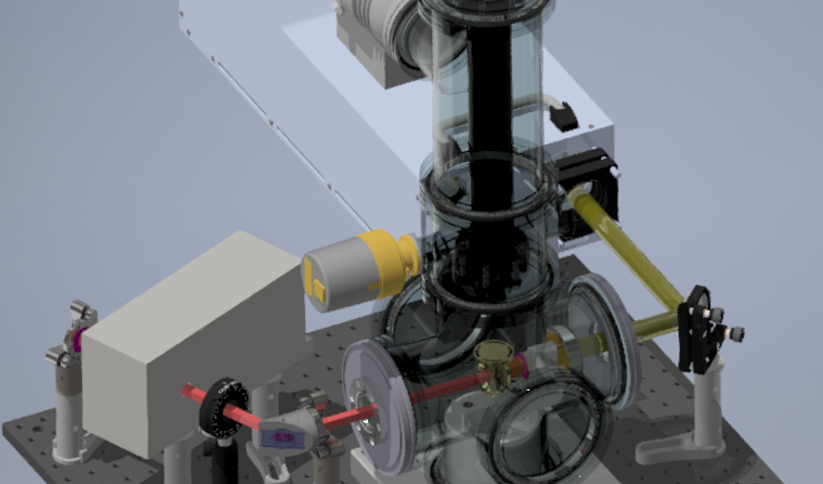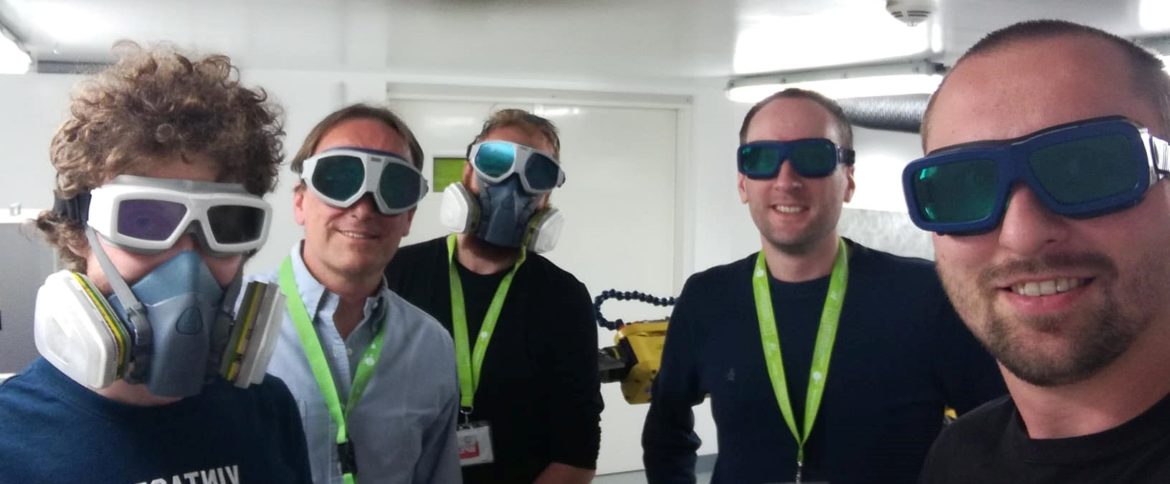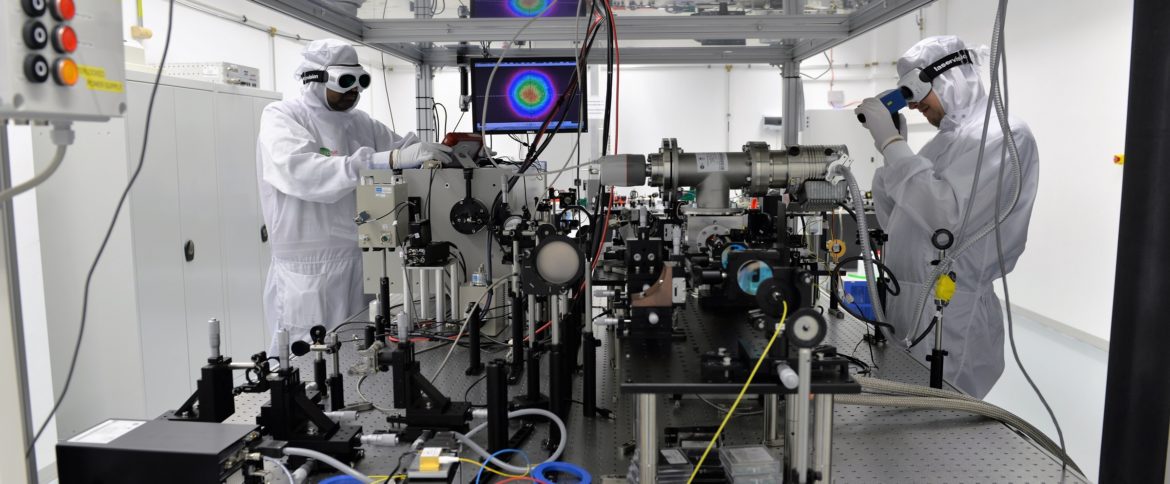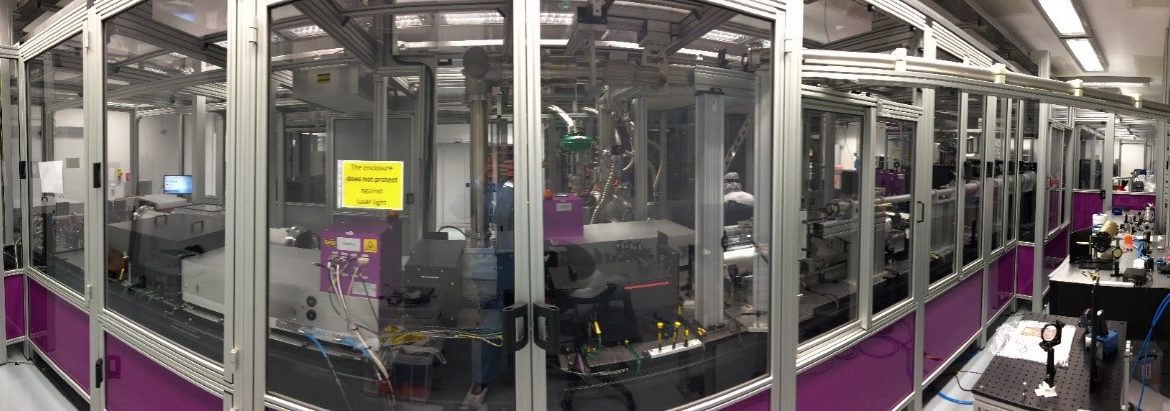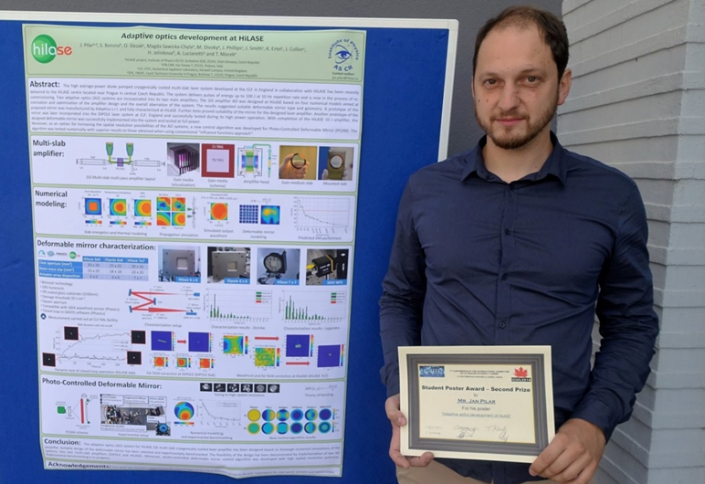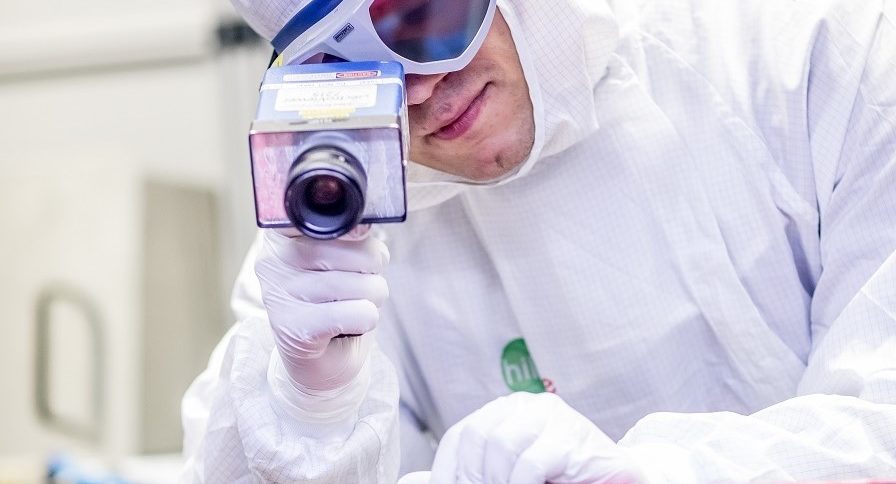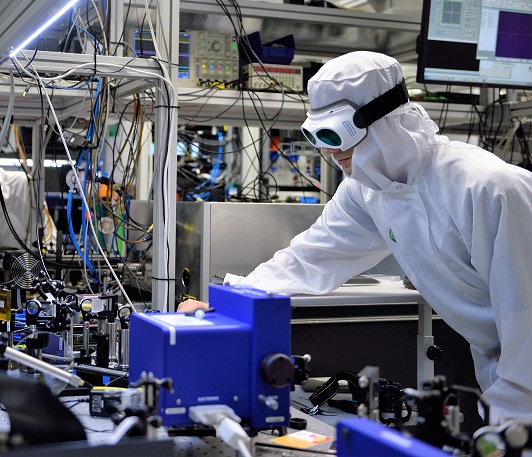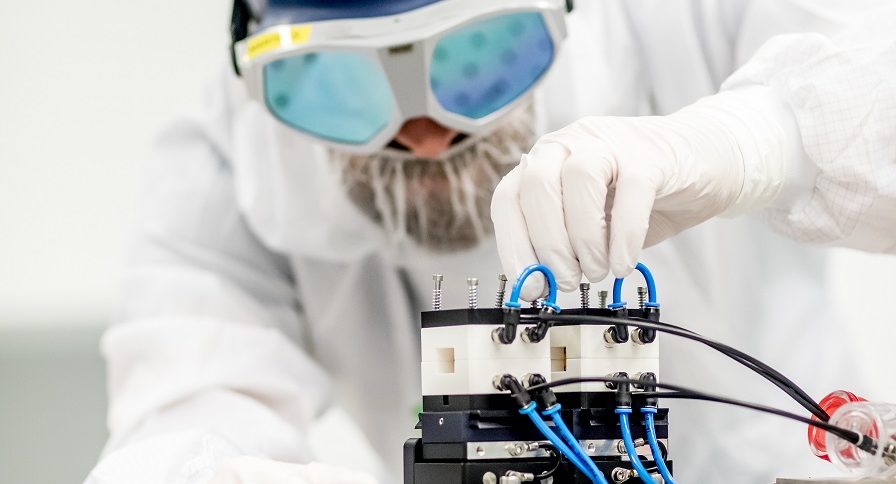ADVANCED LASER DEVELOPMENT (ALD)
We develop high average-power class diode-pumped solid-state lasers, including multi-slab laser architectures and thin-disk based picosecond laser systems reaching average powers up to 1 kW. Our team is also involved in the design and characterization of optical components and systems for high power operation.
![]()
Thin Disk Lasers and Nonlinear Optics
We currently operate four powerful thin-disk laser platforms called “PERLA” operating at the wavelength of 1030 nm. In addition, nonlinear frequency conversion broadens the applicable spectral range from UV (200 nm) to mid-infrared (> 3 µm) making it a versatile tool in many hi-tech industrial, scientific, or biomedical laser applications. Such lasers can be used to drill precise hair-size holes, improve the manufacturing of fast computer chips and large displays, create antibacterial surfaces, and for other applications with high societal impact. Our group focuses on the development of these laser systems since 2012.
We designed the thin-disk laser platform PERLA C by employing a high-average-power regenerative amplifier concept. Using an Yb:YAG gain medium, the average output power is scalable from a few watts up to 1 kW and pulse energy can reach > 100 mJ at the wavelength of 1.03 µm. Typical pulse duration is < 2 ps. Compact femtosecond lasers are currently investigated as well. Recently, we have started to develop a thin-disk laser system (PERLA D) based on Ho-doped gain media generating 2.1 µm laser beams.
In addition, we operate frequency conversion setups for the generation of 2nd, 3rd, 4th, and 5th harmonic frequencies. Conversion to longer wavelength is realized by optical parametric generation (OPG) followed by optical parametric amplification. Such complex optical systems are able to cover a wide spectral range from 206 nm to > 3 um and can serve as an excellent tool for industrial material processing, according to the Industry 4.0 standard in the future. More details.
![]()
High-Energy Slab Lasers
First operation of the multi-slab laser at HiLASE (“Bivoj”) at the end of 2016 demonstrated amplification of 10 ns pulses at 10 Hz pulse repetition rate to an energy of 105 J at 1029.5 nm, representing the world’s first kW average power, high-energy, nanosecond pulsed diode pumped solid state laser. We also work on associated laser technologies, which include high-power optical isolators, adaptive optics, and characterization of laser materials at cryogenic temperatures.
Efficient, high energy, pulsed laser systems operating at high pulse repetition rates (10 Hz and beyond) are required for a wide range of commercial and scientific applications, including advanced materials processing, laser shock treatment of mechanical components, and pumping of ultra-high intensity femtosecond petawatt-class lasers to generate high-brightness secondary radiation (x-ray, gamma-ray) and particle (electron, proton, ion, muon) sources. These lasers have potential applications for novel medical therapies, and in high-resolution radiography and advanced imaging for industrial and security sectors. More details.
New magneto-optical materials for advanced high-power optical isolators
The HiLASE Centre’s Numerical Modelling team, led by Dr. Slezák, jointly with the team from the National Institute for Fusion Sciences (NIFS), Gifu, Japan has successfully characterised the magneto-optical properties of a Potassium Terbium Fluoride (KTF) crystal, manufactured by Northrop Grumman Synoptics, North Carolina, USA.
Learn more.
Ready to build a new customized laser
The thin-disk laser team, led by Dr. Martin Smrž, has successfully demonstrated the stable operation of a pulsed 200-W ytterbium thin-disk laser Perla C using the chirped pulse amplification (CPA) technique. Long term power stability of 0.86 % was recorded over a continuous 2.5 h period. One of the key optical component of the laser system is a new compressor based on dielectric gratings. The laser system is able to produce 1 ps pulses with a beam quality of M2 ≈ 1.4. We are ready to build such a customized laser for our clients.
Figures and more details.
High-energy and compact unstable resonators ready for industrial applications
The HiLASE Centre team, in collaboration with Dr. Koerner from the Institute of Optics and Quantum Electronics of the Friedrich-Schiller University in Jena (Germany), have successfully demonstrated the operation of a compact high-energy pulsed laser based on a novel unstable cavity design. Potential applications of the high-energy unstable resonators include industrial applications like laser shock peening and advanced 3-D printing, and scientific applications like generation of x-rays for biology and medicine.
Read more.
Advanced pulse shaping with Bivoj laser for LSP experiments within OPEN ACCESS
In 2019, a team from the University of Coventry (UK) and the HiLASE LSP team, led by Dr. Brajer, have successfully demonstrated LSP treatment with various pulse shapes. These experiments were performed within the Open Access project titled ‘Mechanisms of life enhancement by laser shock peening surface treatment’. The advanced pulse shaping has been provided by the Bivoj laser team, coordinated by Dr. Divoky. Several pulse shapes were tested, including single Gaussian and Supergaussian pulses with durations from 6 to 14 ns, and double Gaussian pulses each with duration of 3 ns. The materials under investigation were various alloys of aluminum.
Ceramic broadband materials for HAPP Lasers at HiLASE
Development of high average and peak power (HAPP) lasers requires laser materials with broad emission bands along with good thermo-mechanical and thermo-optical properties. Yb doped YAG shows excellent properties at cryogenic temperature which make them attractive material for such lasers. Nevertheless, at cryogenic temperature Yb:YAG exhibit very narrow bandwidth which limits the pulse width of Gaussian transform-limited pulses to pico-second. To address this limitation, we have introduced some disorder in the regular lattice to achieve inhomogeneous broadening in the emission spectra.
Read more.
High energy second harmonic generation with 10 J Bivoj
The Bivoj team, led by Dr. Martin Divoky, and Dr. Jonathan Phillips from STFC, have successfully demonstrated high energy second harmonic generation (SHG) at 515 nm with a nonlinear LBO crystal at Bivoj laser system. The SHG experiment was performed utilizing the nanosecond Bivoj laser system at 1030 nm with an output energy of 5.9 J at 10 Hz. The aperture and the length of the LBO crystal were 25 mm and 13 mm, respectively.
Read more.
Successful operation of Bivoj 10 J laser
The Bivoj team has successfully provided more than 2.5 × 10^7 pump pulses resulting in reliable, stable and high-energy laser operation (2-6 J) in the period of August 2017-July 2018. These laser shots were used for internal tests and for several experimental campaigns, including LSP, LIDT and laser-generated ions. Jan Pilar received a Student Poster Award for his work on ‘Adaptive Optics development at HiLASE’ at the 7th Conference of the International Committee on Ultrafast Intensity Lasers (ICUIL), Montebello, Canada, 11-16 September 2016.
Commissioning of the compact piscosecond 0.5 kW laser system Perla C
The laser system PERLA C, commissioned at HiLASE Centre in 2018, combines half-kilowatt average power, high repetition rate (100 kHz), picosecond pulse duration (1.5 ps) and high beam quality. Such parameters are ideal for high-volume industrial manufacturing and processes ranging from drilling and cutting to surface structuring. The laser was developed together with optical system for wavelength conversion to visible, ultraviolet and mid-infrared spectral regions. Broadening the spectral range then enables even further applications in industry, medicine or research.
Read more.
The most powerful picosecond UV (257 nm) coherent light source demonstrated
Our team has succeded to achieve the highest ouput power for picosecond pulses at a repetition rate of ~100 kHz, including the journal publications and commercial products. The deep ultraviolet radiation around 260 nm is important for materials processing, e.g. it initiates unique phase transitions on surface of some materials (the usage examined at HiLASE Centre), due to the very short wavelength and pulse duration it can be used for very precise microstructuring of surfaces and in lithography, due to the high photon energy (4.8 eV) it enables spectroscopy of electronic transitions in molecules.
Read more.
Patent on Pockels cell holder granted
A new design of Pockels cell holder made by scientists from HiLASE Centre (Institute of Physics of the Czech Academy of Sciences) was patented in 2017. This universal clamping device for high voltage optical elements is eliminating the adverse effects of temperature and frequency of the laser beam. The thermal effects and piezoeletric efects of optical non-linear crystals are also reduced. This holder is suitable for high average power pulsed lasers as a part of pulsepickers, regenerative amplifiers, Q-switchers or Pockels Cells. Inventors are Ing. Luděk Švandrlík and Ing. Martin Smrž, Ph.D.
Read more.
Martin Smrz, Ph.D., department head
Martin Smrz received his PhD degree in applied physics in 2012 from the Czech Technical University in Prague, Czechia, with a topic of PhD thesis Diagnostics of ultrashort laser pulses. Since 2012, he works at the HiLASE Centre, Institute of Physics AS CR, like a member of the ALD dpt. with focus on ultrashort pulse thin disk lasers. He has completed several internships at excellent research institutes or universities like Massachusetts Institute of Technology (USA), Centre for Free Electron Laser of the DESY (Germany), or National Institute for Fusion Science (Japan), where he collaborated on development of hi-tech laser system. He has several patents in the field of laser technology. Currently he focuses on scientific steering of ALD dpt. of the HiLASE Centre and leading undergraduate and postgraduate students.
